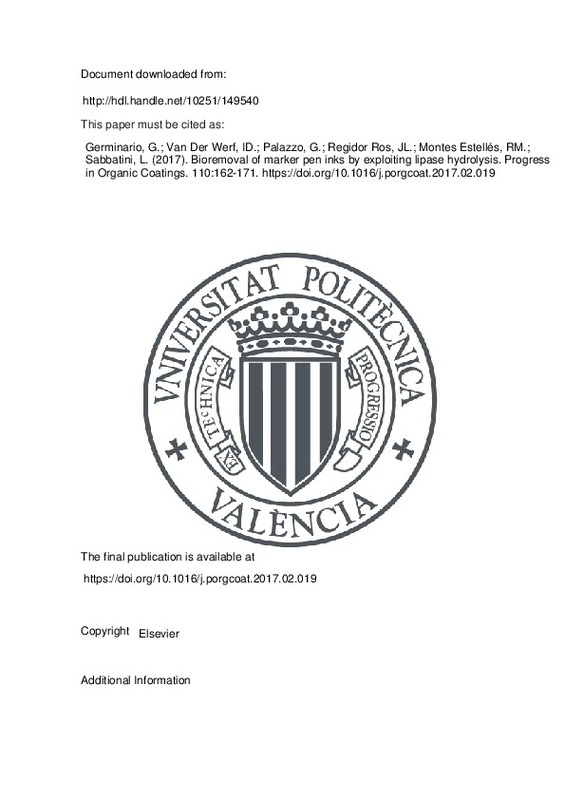JavaScript is disabled for your browser. Some features of this site may not work without it.
Buscar en RiuNet
Listar
Mi cuenta
Estadísticas
Ayuda RiuNet
Admin. UPV
Bioremoval of marker pen inks by exploiting lipase hydrolysis
Mostrar el registro sencillo del ítem
Ficheros en el ítem
| dc.contributor.author | Germinario, Giulia
|
es_ES |
| dc.contributor.author | van der Werf, Inez Dorothé
|
es_ES |
| dc.contributor.author | Palazzo, Gerardo
|
es_ES |
| dc.contributor.author | Regidor Ros, Jose Luis
|
es_ES |
| dc.contributor.author | Montes Estellés, Rosa Mª
|
es_ES |
| dc.contributor.author | Sabbatini, Luigia
|
es_ES |
| dc.date.accessioned | 2020-09-08T03:32:00Z | |
| dc.date.available | 2020-09-08T03:32:00Z | |
| dc.date.issued | 2017-09 | es_ES |
| dc.identifier.issn | 0300-9440 | es_ES |
| dc.identifier.uri | http://hdl.handle.net/10251/149540 | |
| dc.description.abstract | [EN] New and eco-sustainable methods based on the catalytic activity of lipases for the removal of acrylic marker pen inks were investigated. Different biocleaning methodologies were tested using lipases from different sources (viz. bacteria and fungi) dispersed in aqueous systems and microemulsions. Blue, green, red and black marker pens were selected for their chemical composition. Unglazed ceramic substrates were painted using marker pens, and some of these samples were subjected to natural and artificial ageing in order to compare the effectiveness of cleaning methods on fresh and aged ink layers. It was evidenced that acrylic polymer-based inks may be removed with an oil in water microemulsion, but cleaning effectiveness was generally enhanced when a lipase was added. Moreover, it was found that all the tests were more effective on the unaged samples, therefore, the cleaning intervention should be performed as soon as possible. Cleaning effectiveness was evaluated by measuring colour differences, acquiring visible reflectance spectra and determining the percentage of white in images of the treated samples by Image J open source software, for the first time used to this purpose. The results illustrate that only a multi-technique approach can correctly evaluate the effectiveness of different cleaning methods. (C) 2017 Elsevier B.V. All rights reserved. | es_ES |
| dc.description.sponsorship | The present study was carried out with the support of the following projects: PRIN project no. 2010329WPF "Sustainability in cultural heritage: from diagnosis to the development of innovative systems for consolidation, cleaning and protection", financed by the Italian Ministry of Education, University and Research (MIUR); P.O. PUGLIA ERDF 2007-2013, project code 3Z3VZ46 "II restauro delle grandi opere in Puglia: l'innovazione attraverso le nanotecnologie e metodologie diagnostiche avanzate (RESTAUREO)", financed by Puglia Region (Italy); Potenziamento Strutturale PONa3_00369 of the University "A. Moro" of Bari "Laboratorio per lo Sviluppo Integrato delle Scienze e delle Tecnologie dei Materiali Avanzati e per dispositivi innovativi (SISTEMA)", financed by the MIUR (Italy); Fondo di Sviluppo e Coesione 2007-2013 APQ Ricerca Regione Puglia "Programma regionale a sostegno della specializzazione Intelligente e della sostenibilita sociale ed ambientale - Futureln - Research". | es_ES |
| dc.language | Inglés | es_ES |
| dc.publisher | Elsevier | es_ES |
| dc.relation.ispartof | Progress in Organic Coatings | es_ES |
| dc.rights | Reconocimiento - No comercial - Sin obra derivada (by-nc-nd) | es_ES |
| dc.subject | Marker pens | es_ES |
| dc.subject | Graffiti | es_ES |
| dc.subject | Biocleaning | es_ES |
| dc.subject | Lipase | es_ES |
| dc.subject | O/W microemulsion | es_ES |
| dc.subject.classification | PINTURA | es_ES |
| dc.subject.classification | MICROBIOLOGIA | es_ES |
| dc.title | Bioremoval of marker pen inks by exploiting lipase hydrolysis | es_ES |
| dc.type | Artículo | es_ES |
| dc.identifier.doi | 10.1016/j.porgcoat.2017.02.019 | es_ES |
| dc.relation.projectID | info:eu-repo/grantAgreement/MIUR//2010329WPF/ | es_ES |
| dc.relation.projectID | info:eu-repo/grantAgreement/MIUR//PONa3_00369/ | es_ES |
| dc.relation.projectID | info:eu-repo/grantAgreement/Regione Puglia//3Z3VZ46/ | es_ES |
| dc.rights.accessRights | Abierto | es_ES |
| dc.contributor.affiliation | Universitat Politècnica de València. Departamento de Conservación y Restauración de Bienes Culturales - Departament de Conservació i Restauració de Béns Culturals | es_ES |
| dc.contributor.affiliation | Universitat Politècnica de València. Departamento de Biotecnología - Departament de Biotecnologia | es_ES |
| dc.description.bibliographicCitation | Germinario, G.; Van Der Werf, ID.; Palazzo, G.; Regidor Ros, JL.; Montes Estellés, RM.; Sabbatini, L. (2017). Bioremoval of marker pen inks by exploiting lipase hydrolysis. Progress in Organic Coatings. 110:162-171. https://doi.org/10.1016/j.porgcoat.2017.02.019 | es_ES |
| dc.description.accrualMethod | S | es_ES |
| dc.relation.publisherversion | https://doi.org/10.1016/j.porgcoat.2017.02.019 | es_ES |
| dc.description.upvformatpinicio | 162 | es_ES |
| dc.description.upvformatpfin | 171 | es_ES |
| dc.type.version | info:eu-repo/semantics/publishedVersion | es_ES |
| dc.description.volume | 110 | es_ES |
| dc.relation.pasarela | S\353223 | es_ES |
| dc.contributor.funder | Regione Puglia | es_ES |
| dc.contributor.funder | European Regional Development Fund | es_ES |
| dc.contributor.funder | Ministero dell'Istruzione dell'Università e della Ricerca, Italia | es_ES |







![[Cerrado]](/themes/UPV/images/candado.png)

